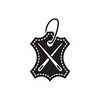British Museum leather dressing
British Museum leather dressing has been used by many conservators since its publication[1][2] to protect and conserve leather.
Formulation
The basic formulation is:
- 200 g anhydrous lanolin
- 30 ml cedar oil (which acts as a fungicide)
- 15 g beeswax (optional)
- 330 ml X-4 (Petroleum ether solvent) or hexane (solvent)
- 200 g anhydrous lanolin
The first three ingredients are mixed warm, then added to the cold solvent and allowed to cool while constantly stirring.[3] Care should be exercised, as hexane is highly flammable.
Variations
There are several variations in the formulation.
Sometimes 60% of the lanolin was replaced by [[neatsfoot oil [Note 1].
One disadvantage of the solvent hexane is its tendency to evaporate rapidly. Before the fat/hexane mixture has been able to penetrate deep into the leather, the hexane evaporates to the surface of the leather, taking most of the fat with it.
While beeswax prevents air pollutants from penetrating the leather, it does this by closing off the leather, thus disturbing the water balance and causing the leather to dry out.[4]
In use
The British Museum leather dressing was part of an elaborate leather conservation program. Other steps entailed cleaning the leather, if necessary, with soap and water and applying an aqueous solution of 7% potassium lactate as a buffer. A warning was given about the dangers of using too much lactate, which made books sticky and could cause fungal growth. The books had to be absolutely dry when the leather dressing was applied.
Apply sparingly to the leather and rub well. Wait two days, then polish the treated leather with a soft cloth. Very hard leather can be soaked in a solution of one part British Museum leather dressing: three parts {{wl}Stoddard solvent}}.[5]
British Museum leather dressing darkens leather, but it is a treatment with a good success record.[3][5]
Notes
- ↑ Neatsfoot oil is a yellow oil rendered and purified from the shin bones and feet (but not the hooves) of cattle. "Neat" in the oil's name comes from an Old English word for cattle. Neatsfoot oil is used as a conditioning, softening and preservative agent for leather. In the 18th century, it was also used medicinally as a topical application for dry scaly skin conditions.
References
- ↑ (Plenderleith, 1946)
- ↑ Plenderleith, H. (1971). The conservation of antiquities and works of art, 2nd, London: Oxford University Press.
- ↑ 3.0 3.1 Caring for Cultural Material - Leather, http://archive.amol.org.au/recollections/2/2/index.htm Accessed: 2007-04-27 article status: dead (Publisher: reCollections - Heritage Collections Council of Australia)
- ↑ Concise survey of conservation treatments, http://www.kb.nl/en/organisation/research-expertise/preservation/guidelines-for-the-conservation-of-leather-and-parchment-bookbindings Accessed: 2007-04-27 (Publisher: Koninklijke Bibliotheek - National library of the Netherlands)
- ↑ 5.0 5.1 Leather Conservation, http://nautarch.tamu.edu/class/anth605/File7.htm#British%20Museum%20Leather%20Dressing%20Treatment Accessed: 2007-04-27 (Publisher: Conservation Research Laboratory, Texas A&M University.)
| Articles related to leather working | |
|---|---|
| See also: |
|
| Types | |
| Substitutes | |
| Leather sources |
|
| Processes |
|
| Crafting |
|
| Hardware | |
| Tools | |
| Leather museums | Leather Archives and Museum |
| Related | |
External links
- More information is available at [ Wikipedia:British_Museum_leather_dressing ]
Chat rooms • What links here • Copyright info • Contact information • Category:Root
